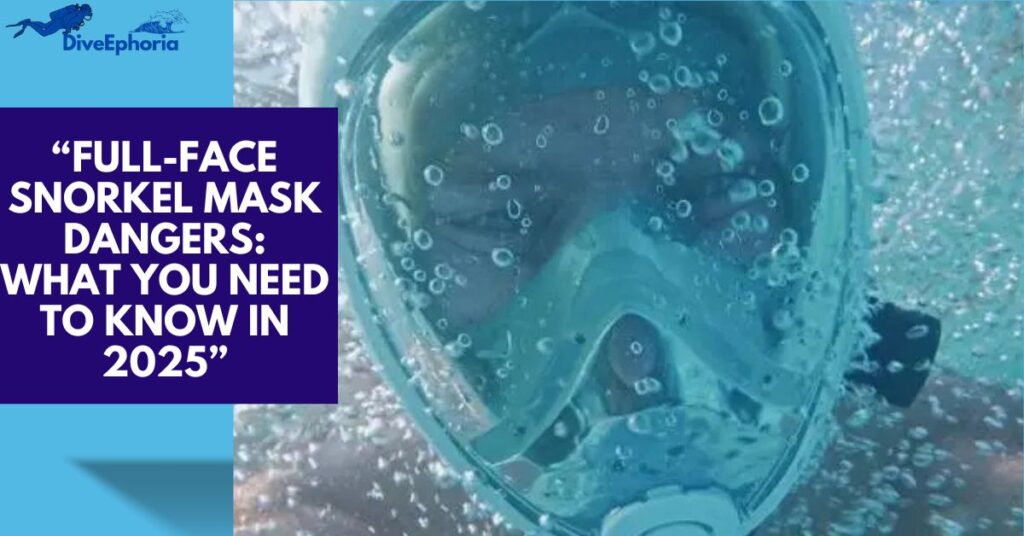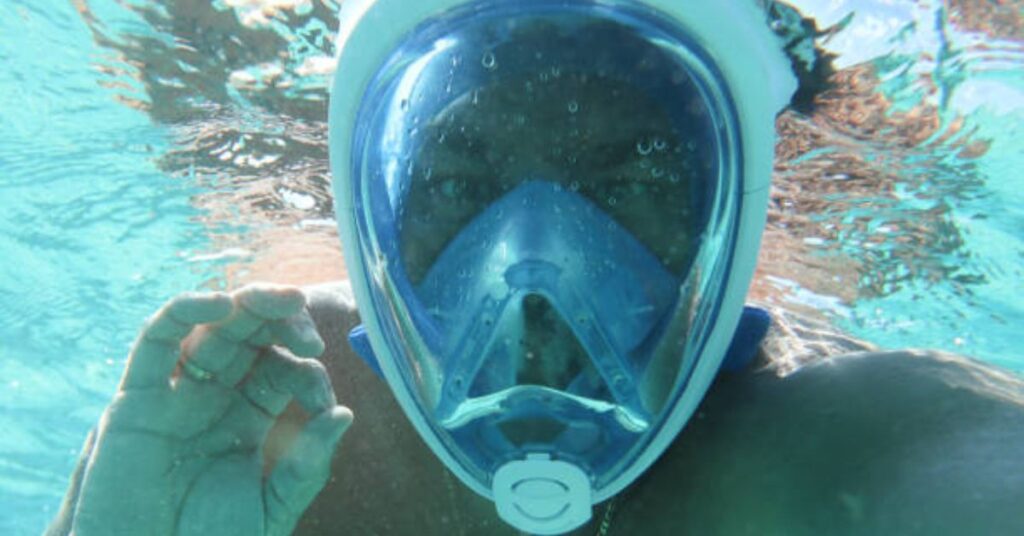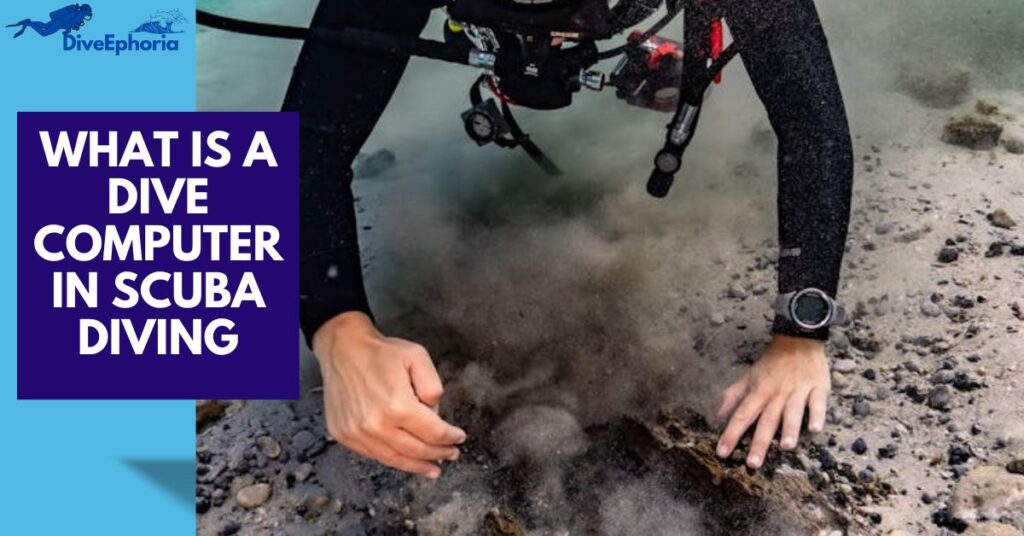
Introduction
Full-Face Snorkel Masks: Understanding the Hidden Dangers and Essential Safety Concerns
Full-face snorkel masks have become increasingly popular among snorkeling enthusiasts, especially beginners, because they promise a more natural breathing experience and a wide, panoramic view of the underwater world. Unlike traditional snorkel sets, which separate the mouthpiece and goggles, full-face masks combine both into a single unit, making snorkeling seem simpler and more comfortable.
However, as their popularity has risen, so too have serious concerns about the safety of full-face snorkel masks. Recent reports and scientific studies have highlighted alarming issues such as carbon dioxide (CO2) buildup inside the mask, difficulties removing the mask quickly in emergencies, and design flaws that may increase the risk of drowning.
This guide aims to answer an important and urgent question: Why are full-face snorkel masks dangerous? We’ll dive into the critical risks associated with these masks, explain how improper design can pose life-threatening hazards, and offer expert advice on how to snorkel safely.
Whether you’re a beginner planning your first snorkeling adventure or an experienced snorkeler considering switching to a full-face model, understanding the dangers of full-face snorkel masks is essential for your safety. By the end of this article, you’ll be better equipped to make informed choices and practice safe snorkeling every time you hit the water.
Understanding the Risks of Full-Face Snorkel Masks

Hidden Dangers of Full-Face Snorkel Masks and What You Need to Know
While full-face snorkel masks offer an attractive alternative to traditional snorkel sets, it’s crucial to recognize the serious risks they can pose if not used properly or if the mask is poorly designed. Understanding these dangers is the first step toward making safer choices and protecting yourself while exploring the ocean.
Here are the major concerns surrounding full-face snorkel masks:
1. Carbon Dioxide (CO2) Buildup: The Silent Threat
One of the most significant dangers associated with full-face snorkel masks is the risk of carbon dioxide buildup. In a traditional snorkel, exhaled air escapes quickly through a simple tube. However, in a full-face mask, the exhaled CO2 must travel through internal chambers before exiting, and if the airflow system is poorly designed, CO2 can accumulate inside the mask.
Breathing in elevated levels of CO2 can cause serious symptoms such as:
- Dizziness and disorientation
- Shortness of breath
- Headaches
- Confusion
- Loss of consciousness in extreme cases
These symptoms can escalate rapidly underwater, increasing the risk of drowning. CO2 buildup risks are particularly dangerous because they can occur even if you feel fine at first, making it a silent and hidden danger.
2. Poor Ventilation and Air Circulation
Not all full-face snorkel masks are created equal. Some lower-quality models lack a properly engineered dual airflow system, which is essential for separating inhaled fresh air from exhaled CO2. Without effective air circulation, snorkelers may unknowingly rebreathe contaminated air, compounding the risk of CO2 toxicity.
Proper airflow is critical to prevent both fogging (which can impair vision) and suffocation hazards during snorkeling sessions. Masks with inadequate ventilation not only compromise breathing but also increase the feeling of claustrophobia, adding stress in the water.
3. Difficulties in Emergency Situations
Full-face snorkel masks can be more difficult to remove quickly compared to traditional snorkel sets. In an emergency—such as water flooding the mask, a CO2-related blackout, or panic—being able to rapidly take off the mask is vital.
Unfortunately, the snug, full-coverage fit that provides the panoramic view also makes quick removal challenging, particularly for beginners or those experiencing panic underwater. A few extra seconds spent fumbling with a tight mask can mean the difference between recovery and a dangerous situation.
4. Quality and Manufacturing Concerns
As the demand for full-face snorkel masks has grown, many inexpensive and poorly manufactured versions have flooded the market. These low-cost masks often lack rigorous safety testing and come with serious design flaws, such as:
- Weak silicone seals that allow water leakage
- Fragile plastic parts prone to cracking
- Faulty purge valves that malfunction under pressure
- Lenses that easily fog up or obscure vision
Purchasing a mask without checking its safety certifications and user reviews can expose you to unnecessary risks. When it comes to snorkeling gear, cutting corners on quality can cost lives.
5. Increased Risk for Certain Populations
Certain groups are at higher risk when using full-face snorkel masks, including:
- People with respiratory issues like asthma or COPD
- Older adults
- Individuals prone to claustrophobia
- Inexperienced snorkelers or non-swimmers
For these individuals, even minor issues like restricted airflow or panic from fogged lenses can escalate into life-threatening emergencies much faster.
Case Studies: Real-World Incidents

Real-Life Examples Highlighting the Dangers of Full-Face Snorkel Masks
Understanding the theoretical risks of full-face snorkel masks is one thing—but real-world incidents provide a much more alarming view of the dangers involved. Across various parts of the world, including popular snorkeling destinations like Hawaii, Australia, and the Caribbean, authorities and researchers have observed a troubling pattern of accidents linked to the use of full-face snorkel masks.
Let’s dive into some notable case studies and research findings that underline the serious risks snorkelers face when using these masks.
Hawaii’s Investigation into Snorkeling Deaths
Hawaii, known for its stunning coral reefs and abundant snorkeling opportunities, has seen a concerning number of snorkeling-related deaths in recent years. Health officials and tourism safety advocates have pointed to full-face snorkel masks as a potential contributing factor in several of these incidents.
Key findings from Hawaii include:
- Many victims showed no obvious signs of distress before suddenly losing consciousness in the water.
- Some deaths were initially thought to be heart attacks or natural causes, but deeper investigations suggested that CO2 buildup and breathing difficulties caused by full-face snorkel masks may have played a role.
- Reports highlighted that several of those who died were inexperienced snorkelers or tourists unfamiliar with the risks associated with these masks.
In response, local authorities have urged snorkel rental companies to educate tourists about the dangers of full-face masks and even suggested limiting their availability until more safety studies are completed.
Scientific Studies and Expert Research
In an effort to understand why snorkeling fatalities were increasing, Hawaii’s State Department of Health and other organizations funded studies specifically looking at full-face snorkel mask dangers.
Findings from these studies revealed:
- Full-face snorkel masks tend to trap exhaled air, increasing the risk of carbon dioxide retention if the mask is not properly ventilated.
- Traditional snorkels had far fewer reported breathing issues compared to full-face designs.
- Test results varied widely by brand, with cheaper, non-certified masks showing the highest risk for CO2 buildup and poor emergency usability.
Scientists concluded that not all full-face snorkel masks are equally dangerous—well-designed models with proper airflow systems performed significantly better. However, due to inconsistent quality across the market, it remains difficult for casual users to easily identify safe models from dangerous ones.
Individual Incident Reports
Several tragic incidents have been attributed, at least in part, to full-face snorkel masks:
- Case 1: Maui, Hawaii
A healthy, middle-aged tourist drowned while snorkeling with a full-face mask. Witnesses said the individual appeared to be swimming normally before suddenly going limp. Post-incident analysis suggested CO2 buildup may have caused unconsciousness before drowning. - Case 2: Queensland, Australia
Authorities issued warnings after two separate non-fatal accidents where snorkelers reported experiencing intense dizziness and breathlessness while using full-face snorkel masks. Quick thinking by nearby snorkelers prevented tragedy. - Case 3: Caribbean Resorts
Several Caribbean resorts now discourage the use of full-face masks for beginners after seeing a spike in reported breathing difficulties and near-miss drowning events linked to these masks.
What These Cases Teach Us
These real-world incidents are a chilling reminder that full-face snorkel masks are not without serious risks. While not every accident can be blamed solely on equipment, patterns across multiple cases suggest that:
- Poor ventilation and CO2 buildup are real threats.
- Inexperienced users are particularly vulnerable.
- Quality and design matter enormously in underwater safety.
Ultimately, these case studies reinforce the urgent need for greater awareness, proper mask selection, and safe snorkeling practices to prevent further tragedies.
How to Snorkel Safely

Essential Tips for Safe Snorkeling with Full-Face Masks and Traditional Gear
Whether you’re using a full-face snorkel mask or traditional snorkeling equipment, prioritizing your safety is critical. With the right precautions, you can enjoy the underwater world while minimizing the risks associated with snorkeling accidents, particularly those linked to CO2 buildup, mask malfunctions, and poor-quality gear.
Here’s a comprehensive guide on how to snorkel safely and make your ocean adventures as worry-free as possible.
1. Choose a High-Quality, Certified Mask
The first and most important step is selecting the right equipment. Not all snorkeling masks are created equal, and this is especially true for full-face snorkel masks.
Look for these features when choosing a safe snorkel mask:
- Certified Safety Standards: Only purchase from reputable brands that conduct third-party testing and meet international safety certifications.
- Dual Airflow Systems: A quality full-face mask should have separate channels for inhaling fresh air and exhaling CO2 to prevent dangerous buildup inside the mask.
- Quick-Release Strap Design: In case of emergency, you must be able to remove the mask quickly and easily.
- Anti-Fog Technology: Clear vision is critical for staying calm and aware underwater.
- Durable Construction: Look for high-grade silicone seals, shatter-resistant lenses, and sturdy snorkel tubes.
Pro Tip: Read customer reviews and consult snorkeling experts before purchasing a full-face mask, especially if you’re buying online.
2. Perform a Safety Test Before Each Use
Even the best snorkel mask can malfunction if it’s not properly maintained or fitted.
Here’s how to perform a quick pre-snorkel safety check:
- Fit the Mask Properly: Make sure the mask seals tightly against your face without discomfort or air leaks.
- Check for Obstructions: Ensure the snorkel tube and airflow valves are clear of sand, debris, or salt buildup.
- Test Breathing Comfort: In shallow water, practice breathing calmly through the mask to ensure there’s no resistance or shortness of breath.
- Monitor for CO2 Symptoms: If you experience dizziness, fatigue, or difficulty breathing during testing, remove the mask immediately.
Never ignore early signs of CO2 buildup or ventilation problems, even during short practice sessions.
3. Know When to Avoid Full-Face Masks
Although full-face masks offer many conveniences, they are not ideal for every snorkeling situation.
Avoid using full-face snorkel masks if you:
- Plan to snorkel in rough seas or strong currents, where exertion and stress levels are higher.
- Have pre-existing respiratory conditions like asthma, COPD, or chronic bronchitis.
- Are prone to panic attacks or claustrophobia, which could worsen if the mask fogs or airflow is restricted.
- Are engaging in free diving or diving deep underwater, which these masks are not designed for.
In these cases, a traditional snorkel and mask set offers greater flexibility, easier emergency removal, and fewer risks.
4. Stay Aware of Your Body’s Signals
Listening to your body is one of the best ways to stay safe while snorkeling.
Watch for warning signs like:
- Unusual tiredness or fatigue
- Dizziness or lightheadedness
- Shortness of breath
- Tightness or pressure in your chest
- Disorientation or blurred vision
If you experience any of these symptoms, stop snorkeling immediately, remove the mask, and get out of the water. It’s better to cut an excursion short than to risk a medical emergency.
5. Snorkel with a Buddy
Never snorkel alone—this is one of the most important rules of safe snorkeling. Having a buddy ensures that someone can assist you if:
- You experience equipment failure
- You become disoriented
- You have a medical emergency
A buddy can also spot hazards like strong currents, sudden weather changes, or dangerous marine life more quickly.
6. Stay Informed and Educated
Before you snorkel at any new location, take time to learn about local water conditions, currents, and safety guidelines. Some locations, like Hawaii and parts of Australia, offer snorkeling safety courses or briefings that are highly recommended, especially for beginners.
Bonus Tip: Always inform someone on land where you are snorkeling and when you plan to return.
Final Thoughts on Snorkeling Safety
Snorkeling is one of the most rewarding ways to experience marine life, but it carries real risks—especially when using a full-face snorkel mask. By investing in high-quality equipment, performing regular safety checks, snorkeling with a buddy, and staying alert to your body’s signals, you can enjoy a safer and more enjoyable underwater adventure.
Remember: Your safety is always worth more than convenience.
Conclusion
Balancing Convenience and Safety: The Final Word on Full-Face Snorkel Masks
Full-face snorkel masks have undeniably changed the way many people experience snorkeling. Their user-friendly design, panoramic viewing experience, and natural breathing system make them attractive, especially for beginners and casual snorkelers. However, it’s essential to remember that convenience should never come at the expense of safety.
Throughout this guide, we have explored the real risks associated with full-face snorkel masks, including:
- Carbon dioxide (CO2) buildup, which can cause dizziness, unconsciousness, and even drowning
- Poor airflow design that leads to dangerous rebreathing of exhaled air
- Structural and manufacturing flaws in lower-quality masks
- Difficulties in emergency situations when quick removal of the mask is needed
We’ve also reviewed real-world case studies, particularly from locations like Hawaii and Australia, where snorkeling deaths and incidents have raised serious concerns about full-face mask safety. Scientific studies have validated these fears, emphasizing that proper equipment selection and usage are critical to preventing accidents.
Key Takeaways for Snorkeling Safely
- Always choose a high-quality, safety-certified mask from a reputable brand.
- Perform a full safety test before entering the water.
- Understand your personal health risks, especially if you have respiratory conditions or anxiety disorders.
- Never snorkel alone—always have a buddy in the water.
- Stay alert to your body’s warning signs and exit the water at the first sign of trouble.
While full-face snorkel masks can offer a wonderful experience when used properly, they are not ideal for everyone or for every situation. In some cases, traditional snorkel sets may be the safer, more reliable choice.
Ultimately, your enjoyment of snorkeling should be matched by a strong commitment to safety. By staying informed, cautious, and prepared, you can explore the beauty of the underwater world with greater confidence and peace of mind.
FAQS:
Are full-face snorkel masks safe?
They can be safe if designed with proper ventilation and used correctly. However, poor-quality models increase safety risks.
How do I know if my full-face mask is dangerous?
Look for signs of CO2 buildup, difficulty breathing, or poorly constructed materials.
Can full-face snorkel masks cause drowning?
Yes, they can contribute to drowning if they trap CO2, impair breathing, or fail in an emergency.
What are the best alternatives to full-face snorkel masks?
Traditional two-piece mask and snorkel setups are considered safer and allow for better air exchange.
Are there regulations on full-face snorkel masks?
Some regions, such as Hawaii, are investigating regulations due to safety concerns.


